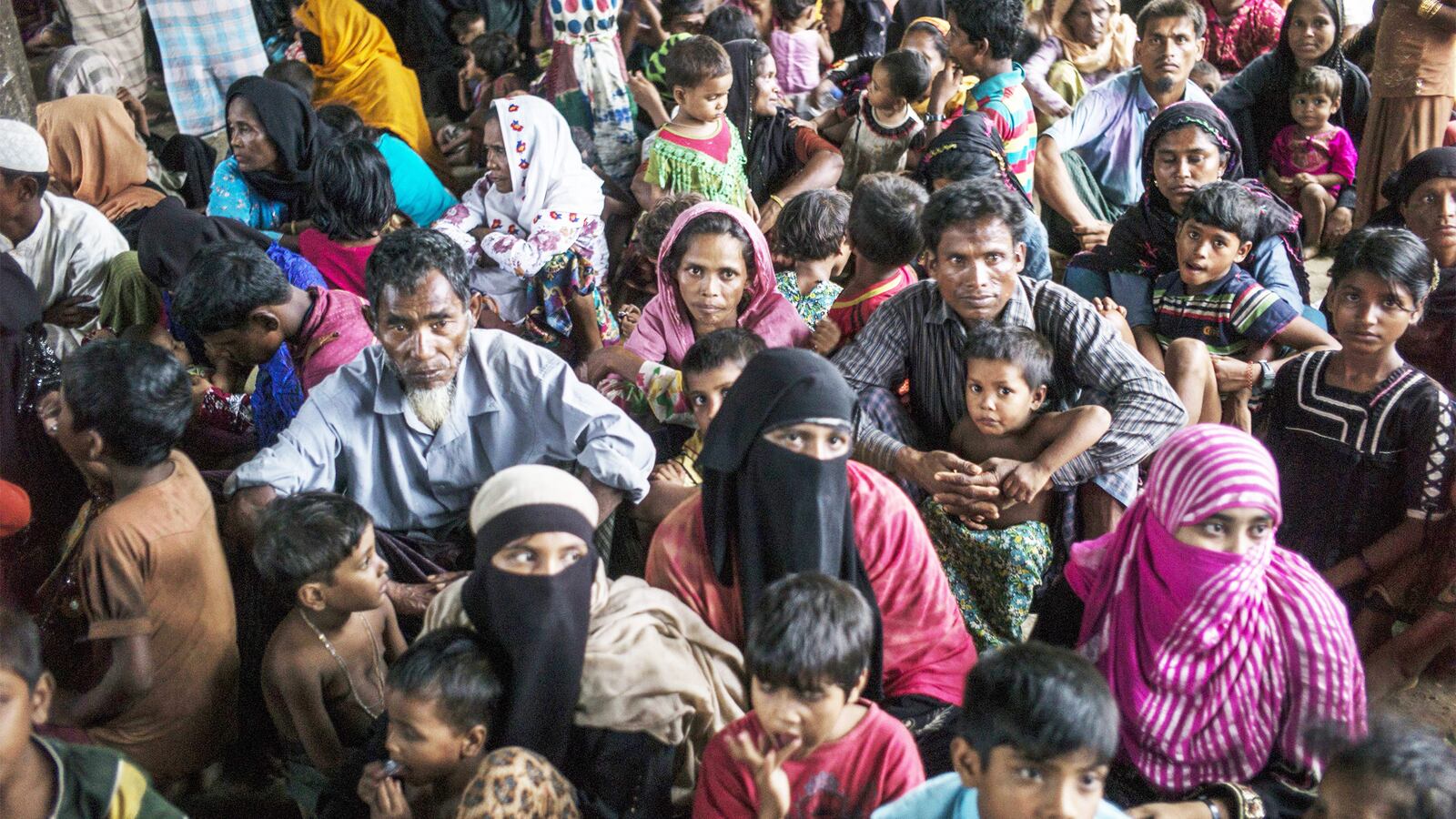At the end of August, Myanmar’s military unleashed operations in response to what it described as terrorist attacks on at least 20 police stations in its western state of Rakhine. What followed has yet to be documented in full, but Bangladesh has accused Myanmar’s military of burning 10,000 homes, and according to satellite imagery from Human Rights Watch, hundreds of villages in Rakhine state have been obliterated. More than 420,000 minority Rohingya Muslims have fled across the border to Bangladesh, where hundreds of thousands are already official or unofficial refugees from a similar exodus more than 20 years ago.
State Counselor Aung San Suu Kyi, a former democracy activist and now the leader of the governing party, misrepresented and minimized military actions in the region this week. She further suggested that the government does not understand why hundreds of thousands of people would flee to another country. The United Nations High Commissioner for Human Rights has warned that based on the information available so far, the crisis appears to be a “textbook example of ethnic cleansing.”
In this excerpt from my book One Long Night: A Global History of Concentration Camps, I trace my 2015 trip to Rakhine state, diving into the messy history of the region, how it came to have detention camps that may have fueled insurgency, and the rationale those in the state capital use to justify keeping their former neighbors in camps. All these pieces are critical to understanding events happening today—events likely to get worse with the government’s announcement this week that it intends to build seven new Rohingya-only camps in the vicinity of the razed villages.
-------
A flight through Korea or Thailand to Yangon in Myanmar and a short hop on a smaller plane can carry anyone to the Bay of Bengal and Sittwe, the capital of Rakhine state. Trees heavy with giant fruit bats and what appear to be ten rickshaw drivers and one mini-truck cabbie per capita compete for any foreigner's attention. The town boasted nearly two hundred thousand residents a decade ago, but many of those inhabitants no longer live in Sittwe, having been relegated to detention camps on the outskirts of town.
In the summer of 2012, reports of a gang rape and other violent crimes stirred tensions between Buddhist and Rohingya Muslim communities across Rakhine state. In response to the escalating violence, extremists led riots that October that burned thousands of Rohingya out of their homes. Vandalized mosques were boarded up; one was converted to a police station.
Under the state of emergency declared by the federal government, the Rohingya population throughout the region was loaded onto buses and trucks and dropped off on the outskirts of their hometowns, near Rohingya-only enclaves, or in the middle of nowhere, eventually ending up stuck in the kinds of camps for Internally Displaced Persons (IDPs) typically seen during wars and natural disasters. In some cases armed guards stopped extremists from additional pogroms, but they also kept the Rohingya detainees from leaving.
The only Rohingya permitted to stay in the city of Sittwe have been sealed off in Aung Mingalar, the Muslim Quarter, which has become an extension of the camp system that has risen around the state. Roads leading into the district are blocked at checkpoints by red-and-white sawhorses wrapped in barbed wire, creating a ghetto in the middle of a city filled with Buddhists, Christians, and a panoply of other ethnic groups the Rohingya lived among and did business with not long ago. Most residents of the state endured rural poverty even before the advent of the camps, but in the relative prosperity of Sittwe, many Rohingya had assimilated into urban life, working in construction or making eyeglasses and plate-glass windows. Some had attended the city university.
Since the 2012 violence, segregation has been enforced. But the borders of the camps are somewhat permeable. A few Rohingya work as day laborers for the military. As with many prior camp systems in other countries, nongovernmental groups enter to coordinate aid to the displaced populations, and journalists sometimes get government permission to visit the camps—or failing that, are able to bribe their way in, if they do not mind putting their fate in the hands of strangers.
Camp structures vary widely up and down the narrow blade of the coastal state, as do camp communities, but around Sittwe, hustlers work both sides. Outside drivers cart visitors or goods into the camps, selling the latter at exorbitant rates. Some detainees save their food rations to sell to those outside the camps, though they always take a loss, dependent on the mercy of their buyers.
With a little cash, Rohingya entrepreneurs can import comfort foods from town, which they offer to fellow detainees for a profit. In some places longhouse frontage has been converted to small kiosks, with neatly hung rows of packaged goods and stacked canned sodas. A tiny money supply circulates and recirculates in a frenzy, constantly bled off by outsiders. One preteen shopkeeper in Dar Paing Camp in 2015 had taken the business over from his brother, who finally gathered enough money to pay a trafficker to deliver him from Myanmar into another country.
Across the first years of the camps' existence, day-to-day life was unpleasant but more stable than not. A sense of suppressed violence lingered, however, and reports of assaults by extremists haunted the detainees on a regular basis. Spies and informers lurked everywhere.
In 2015 soldiers in the Muslim quarter carried assault rifles, and security police patrolled with pistols. The guards were generally not from Rakhine state, and so lacked some of the local hatred for the Rohingya. Camp detainees were emphatic about wanting detention to be lifted so they could come and go at will, but at that point did not seem to mind the armed protection, and at times expressed gratitude for its presence.
Approximately 4,000 residents live in the quarter itself. Another 120,000 people or so were corralled across the state in camps created for those who lost their homes in the violence. Add in the Rohingya who did not flee their homes but who nonetheless one day found government barricades and checkpoints set up on the outskirts of their villages, and you get more than a million stateless people who live with some form of government segregation or communal detention in Rakhine state.
Early in the process, the then president of Myanmar denounced the 2012 riots and declared that local leaders' role in it would be investigated. But the country was in the first stages of transition from a military dictatorship to democracy. No one was taken to task, and eventually it was understood that the government found the situation to its advantage.
Those who were in Sittwe during what interpreters refer to as "the violence" tell of fire and pursuit, of fleeing homes without time to grab identification papers and family photos, let alone retrieve practical items. They describe the shock of recognizing their neighbors among the attackers, and of seeing law enforcement standing by without intervening. Some residents fled the fire by heading into the small lake bordering the Muslim district of Aung Mingalar, where two women were reported giving birth in the mud during the riots. Hundreds were killed across the state.
As the camps took shape, international aid organizations negotiated a sometimes bumpy partnership with the government to ensure clean water sources via wells, to provide food, and to make inroads toward health care and sanitation. Registries of the dispossessed were kept to track the food assistance that was soon forthcoming, but in many cases residents were cut off from fishing, farming, and skilled work.
The poverty in Rakhine state is such that many local extremists have used the food, latrines, and wells provided to the Rohingya in camps as a kernel around which to build additional resentment, describing them as luxuries provided preferentially to Muslims by biased outsiders. Most people in Rakhine state do not have access to latrines. The town of Sittwe itself was not on an electrical grid until years after the creation of the camps.
The ghetto holds ghosts of an era in which at least some Rohingya managed middle-class lives. The nicest homes—a few still have their glass windowpanes—run slowly to ruin in the blistering humidity. Less sturdy houses fall apart in the ebb and flow of flooding. Plastic sheeting with a UN logo slowly replaces standard repairs, a concession to the ravages of isolation and dependence. Trees and vines grow over early improvised graves behind the mosque, while boys and girls in bright green-and-white uniforms gather outside their school. For those who are able to attend, the open-air patch between classrooms lies half buried in muck and standing water. A plaster sign announces that Japan provided for the school's construction in 2005, a reminder that poverty and need for outside help have long existed in Sittwe. But it turns out that things can always get worse.
Outside town, the IDP camps are less vivid, their rows of living quarters arranged in grids, though people try to reclaim any arable inch for growing plants. As in Aung Mingalar, ducks, dogs, goats, and straw-colored hens run everywhere. Children follow strangers, having little else to do. Detainees live in longhouses, eight units to a building, with one roughly ten-by-ten foot room for each family—whether the family has three or eight members. Each family shares a well, a semiprivate space for bathing, and a communal hallway with the other longhouse residents.
At first the Rohingya were allowed to pay for temporary travel permits to other parts of the country, but these passes can no longer be had. Residents must use a bus, for which they pay a fare, that will ferry them only to visit other Rohingya in nearby camps. When tensions rise, bus travel is halted.
In 2015, thousands of Rohingya were smuggled by traffickers into other countries in hopes of greater freedom or paying jobs. Some did illegal work; others found only detention or even death at the hands of traffickers. Unless they resort to this expensive and dangerous human trafficking, even Rohingya who manage to flee Myanmar are also stuck. Having declared them illegal immigrants, their own country will not take them back, and the ones to which they have fled do not want them.
As the flood of refugees has increased, neighboring countries have worked to block thousands of incoming Rohingya. Bangladesh, which counts more than thirty-two thousand registered Rohingya in its official refugee camps just across the border from Myanmar, regularly threatens to move them to an uninhabitable island. In addition to those officially registered, the country has also been home for decades to hundreds of thousands of unregistered Rohingya, who live in and near the existing camps without legal rights or protection.
But these Rohingya refugee camps differ from those inside Myanmar, in that the former hold populations from other countries, while the latter maintain a vulnerable population still at risk in deliberate segregation from their fellow countrymen. The Rohingya inside Rakhine state continue to live as internal refugees in close proximity to the very people who resorted to violence against them.
The successful effort to label them as foreigners has emboldened those who wish to deny them rights, despite the fact that Rohingya culture has roots going back centuries in the region, with the term appearing in a 1799 treatise on local Rakhine dialects. In an attempt to tar all Rohingya Muslims as illegal immigrants, the state government has long refused to grant any validity to the word, referring to the group as "Bengali."
Officially, the Rohingya were cut off from full citizenship in 1982, though for many years the law was not enforced, and they were able to run as candidates and vote during the few opportunities that had arisen on Myanmar's halting, aborted, and resurrected road toward democracy. In early 2015, however, anticipating the national elections that November, the government confiscated even the temporary ID cards that the Rohingya had held, rendering them stateless.
The Rohingya are the pariah group of Myanmar, but their most enthusiastic jailers, the Rakhine, are also looked down on by the rest of the country. The generals of the dictatorship had no love for Rakhine state, generally treating it as a backwater of hayseeds and traffickers whose natural resources and strategic port were best auctioned off to China for the benefit of those in the capital.
The generals in turn inspired no love in Sittwe, with their surveillance and detentions under the military boot. Before the dictatorship, there was British rule, and before that, there was the invading Burmese king Bodawpaya—successive overlords who provided a reasonably accurate unbroken line of grievance stretching back to at least 1784. This grievance helps the Rakhine people feel entitled to exert whatever power they can today.
Sitting in a restaurant in Sittwe in 2015, not long before the election, U Shwe Mg of the Rakhine Nationalist Party says, "We are a peaceful people. We want peace. But we can only take so much." Asked how he still interprets the Rohingya as a threat when it is overwhelmingly the Rohingya who are in camps, he changes the subject.
Insisting that he is not speaking for his party, he says that in the face of illegal immigration that threatens to swamp the state, the Rakhine people have a right to determine their own destiny. The Rohingya care nothing for education, he explains, claiming that they are religious extremists. He says this without apparent irony, disregarding the slogans of hate that emerged from the 969 Buddhist extremist movement advocating legal restrictions against Muslims.
He says that he does not want violence and declares the camps a good solution for now—though deportations should follow. He refers to the citizenship law of 1982 that laid the groundwork for the Rohingya officially being rendered stateless, but does not note any of the reasons it was enacted or extenuating details about its implementation. He says that all he wants is for the law to be followed, and borrowing a democracy movement catchphrase, asks, "You do believe in the rule of law, don't you?"
Drivers who smuggle journalists or contraband in and out of the camps have their own opinions. One who was born and raised in Sittwe and has never lived anywhere else opens up about the local situation, saying the Rohingya are a problem. Asked about those he grew up with in town—the ones whose parents and grandparents were also born there and ran small businesses or went to school nearby—he expresses mixed feelings. The good ones can stay, he says, but the bad ones must go. He acknowledges that some harm may have been done to those in the camps, but repeats the refrain offered by many in Rakhine state: "We have a right to defend ourselves."
Some Rohingya have managed to keep their cell phones in detention, allowing them to share public information, call for help in emergencies, and build public awareness around the world. One entrepreneur brought a solar panel into one of the camps that residents can use to recharge their devices.
Complaints about lack of access to education and emergency medicine proliferate on social media. Links to government announcements are shared, as are privately circulated reports of violent abuse by security forces, subject to the same confusion and risks as any accounts on social media. The Rohingya may be the first group in the history of mass detention to launch their own digital public relations effort from inside their concentration camps.
Conditions remained bad enough in 2015, or hopeless enough, that many people continued to resort to dangerous tactics in order to flee. Before rainy season closed off the Bay of Bengal as an escape route, thousands of Rohingya set out with traffickers who charged staggering fees to deliver them to new countries. Myanmar's government would have been happy to see them go, but other countries do not want the refugees. Myanmar has learned that it cannot empty its camps this way.
In the meantime, the U.S. Holocaust Memorial Museum released a report the same year, warning that the Rohingya "are at grave risk for additional mass atrocities and even genocide." Others declared that genocide was already underway, based on reported mass executions that have been hard to confirm. Then senior researcher on Burma for Human Rights Watch David Scott Mathieson felt that applying the genocide label in mid-2016 was an overreach for the moment, though he condemned Myanmar's failure to include the Rohingya in an earlier census, as well as their stateless condition. "The government," he said, speaking of the pre-election regime, "shouldn't be caving to extremists and their racist agendas."
A visit to the Sittwe-area camps reveals a culture leaching away, with few education and work possibilities, untreated chronic health conditions, and a people turned into scapegoats in order to pacify the demands of another minority, one with its own history of victimization by the government. When presidential elections in November 2015 brought democracy activist Aung San Suu Kyi's party to power, the Rohingya appeared cautiously elated, despite a comment Suu Kyi had made claiming that the media made the situation in Rakhine state worse by exaggerating the problem.
What changes would even be possible remained unclear, since democratic rule was hobbled by the 25 percent of seats in the national legislature reserved for the military—a legacy of dictatorship. After no changes appeared in the first one hundred days and little pressure had been exerted on behalf of those detained, even cautious optimism faded.
Former UN secretary general Kofi Annan was named chairman of a committee in Rakhine state to resolve the issue of the Rohingya, and met with citizens and detainees alike. On the day of his arrival in Sittwe, more than a thousand locals gathered at the airport to protest what they saw as outside interference in their affairs. Progress seems unlikely without a non-Rohingya champion for Rohingya rights who is from Myanmar itself. There may not be a leader willing to take up that mantle.
In October 2016, the stasis that had held for years was shattered after an attack on three border posts reportedly left nine police officers dead in the area of Maungdaw, which borders on Bangladesh. The government identified the attackers as insurgents. In the days that followed, government troops proceeded to close the region to observers and use automatic weapons and helicopter gunships to kill dozens of Rohingya.
Despite the lack of access to some areas, satellite imagery confirmed the destruction of villages in the region. Reports of a campaign of rape and the deaths of more than one thousand Rohingya were relayed by those seeking refuge on the border with Bangladesh. In February 2017, the Office of the UN High Commissioner for Human Rights confirmed many of these reports, documenting the "devastating cruelty" of summary executions and burning people alive, and calling for a "robust reaction" from the international community. The government has repeatedly denied aid groups and journalists access to areas targeted for military action.
Though camps in Rakhine state had initially provided some security in the wake of the 2012 riots against the Rohingya, by normalizing the group's detention and encouraging their demonization for years, the state and national government turned detainees into sitting ducks for a military with an atrocious human rights record—a military that the country's new leadership may not yet be strong enough to defy, if it is even inclined to try.
Standing in Dar Paing Camp in 2015, surveying an open stretch of field just outside Sittwe, it appears that despite sections of heavier fencing, there are places where perimeter security is more relaxed. Even if someone lacks the money to pay traffickers to get to another country, it seems possible to slip away at night and stay clear of the roads—to make an escape.
But the ability to leave the camps may not be the biggest barrier. Little sympathy exists in the surrounding community for the Rohingya as citizens, neighbors, or human beings. Dismissing the possibility of departure, an interpreter giving a tour of the camp says, "Where would I go? Everyone would know I am a Rohingya."
Asked what would happen if he were caught outside the camp, he stops to consider the question. "I have no rights. If I am caught, I do not even exist."
Excerpted from One Long Night: A Global History of Concentration Camps by Andrea Pitzer, copyright ©2017 by Andrea Pitzer. Used with permission of Little, Brown and Company, New York. All rights reserved.






